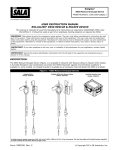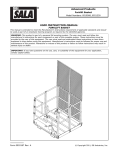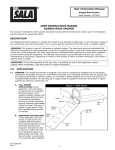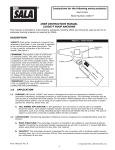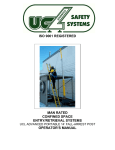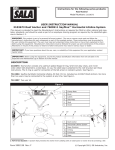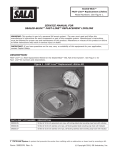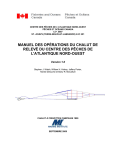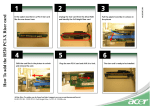Download UseR INsTRUcTION MANUAl ROllGlIss® R520
Transcript
Rollgliss® R520 Escape Device Model Numbers: (See back pages.) User Instruction Manual Rollgliss® R520 Escape Device This Manual is intended to meet the manufacturer’s instructions as required by EN 341:2011. It should be used as part of an employee training program as required by AS/NZS 1891. WARNING: This product is part of an emergency rescue system. The user must follow manufacturer’s instructions for each part of the system. These instructions must be provided to the user of this equipment. The user must read and understand these instructions before using this equipment. Manufacturer’s instructions must be followed for proper use and maintenance of this equipment. Alterations or misuse of this equipment, or failure to follow instructions, may result in serious injury or death. IMPORTANT: For further information and questions on the use, care or suitability of the R520 Escape Device for your application please contact Capital Safety. This instruction describes installation and use of the Rollgliss R520 Escape Device. This instruction should be read and understood before using the R520 and used as part of an employee training program. IMPORTANT: Before using the R520 Escape Device, record the product identification information from the ID label into the Inspection and Maintenance log in this manual. description: The R520 Escape Device (Figure 1) is available for Descent application only. The R520 can be installed in a mountable box for bucket truck applications (rope lifeline lengths up to 150 m [492 ft]; rope lifeline length capacities vary by rescue box). It can be also be stored in a backpack style bag when used with long rope lifeline lengths and non-bucket truck applications. Figure 1 - R520 Escape Device Rollgliss R520 Bucket Truck Application Models, Rollgliss R520 Long Rope and Non-Bucket Truck Application Models, 5 m (16.4 ft) to 150 m (492 ft) Rope Lifeline Lengths (length capacity varies by Rescue Box) 5 m (16 ft) to 150 m (492 ft) Rope Lifeline Lengths B B A A C C H F F D D G E Form: 5903417 Rev: A A R520 Descent Unit B Body Connector (Carabiner) C Labels D Rope Lifeline Lifeline Connector E Lifeline Connector Mountable Rescue Box (shown mounted on bucket truck G) F RFID Tag A R520 Descent Unit B Anchorage Handle C Labels D Rope Lifeline E F G Bucket Truck H RFID Tag E © Copyright 2012, DB Industries, Inc. 1.0Application 1.1Purpose: The Rollgliss R520 Escape Device is intended to lower one person from an elevated height to a lower rescue station. Several people may use the device to descend, one after another. The descent speed is automatically limited during the descent. WARNING: The Rollgliss R520 Escape Device must not be used as a fall arrest device. 1.2LIMITATIONS: The following application limitations must be recognized and considered before using this product: A.CAPACITY: Required capacities and descent distances for the Rollgliss R520 are as follows: Users Total Weight (including tools, clothing, etc.) Max. Descent Distance Number of Descents 1 Person 59 kg (130 lbs) - 150 kg (331 lbs) 150 meters (492 ft) 6 1 Person 59 kg (130 lbs) - 100 kg (220 lbs) 150 meters (492 ft) 9 1 Person 59 kg (130 lbs) - 75 kg (165 lbs) 150 meters (492 ft) 12 B. DESCENT SPEED: The speed at which the user(s) will be lowered when using the Rollgliss R520 Escape Device increases with the weight of the user. The approximate descent speed is 0.6 - 0.9 meters per second (2 - 3 ft per second). C. HAZARDOUS AREAS: Use of this equipment in hazardous areas may require additional precautions to reduce the possibility of injury to the user or damage to the equipment. Hazards may include, but are not limited to: high heat, caustic chemicals, corrosive environments, high voltage power lines, explosive or toxic gases, moving machinery, and sharp edges. D. TRAINING: This equipment is intended to be installed and used by persons trained in its correct application and use. 1.3 Applicable Standards: The R520 Rollgliss Escape Device conforms to EN 341:2011, ANSI standard Z359.4 2007, NFPA 1983, and federal (OSHA) standard requirements governing the use of this product. 2.0 System Requirements 2.1 COMPATIBILITY OF COMPONENTS: DBI-SALA equipment is designed for use with DBI-SALA approved components and subsystems only. Substitutions or replacements made with non-approved components or subsystems may jeopardize compatibility of equipment and may effect the safety and reliability of the complete system. 2.2 COMPATIBILITY OF CONNECTORS: Connectors (hooks, carabiners, D-rings) used to suspend the R520 Escape Devices must be capable of supporting at least 15 kN (3,100 lbs). Connectors must be compatible in size, shape, and strength. Non compatible connectors may unintentionally disengage (rollout). Roll-out occurs when interference between the connector and anchorage connector causes the hook or carabiner gate to unintentionally open and release. Self locking snap hooks and carabiners must be used with this system to reduce the possibility of roll-out. Do not use connectors that will not completely close over the attachment element. 2.3 ANCHORAGE STRENGTH - R520 Escape Device: Anchorages used to suspend the R520 Escape Device must sustain static loads applied along the axis of the device. When more than one R520 Escape device is attached to an anchorage the anchorage strength requirement must be multiplied by the number of descent devices attached to the anchorage. It is recommended that the strength of the attachment be at least 15 kN or (3100 lbs). If being used in Europe the attachment strength should be at least 10 kN (2248 lbs) and conform to EN795. If being used in Australia or New Zealand the anchorage strength should be at least 12 kN (2700 lbs.) and conform to AS/NZS 1891. WARNING: If greater anchorage strength requirements apply where the Rollgliss R520 Rescue Device will be used, anchorages must comply with that requirement. It is the responsibility of the user and purchaser of this equipment to be trained in the correct care and use of this equipment. The user and purchaser must be aware of the operating characteristics, application limits, and consequences of improper use of this equipment. Warning: Training must be conducted without exposing the trainee to a fall hazard. Training should be repeated on a periodic basis. 2 3.0 Installation and use 3.1 Before each Use: Carefully inspect the R520 Escape Device in accordance with Section 5 of this manual. 3.2Planning: Plan your emergency escape system and how it will be used before starting your work. Consider all factors that will affect your safety before, during, and after an escape. Consider the following when planning your system: A.ANCHORAGE: Select a rigid anchorage point that is capable of supporting the load as specified in Section 2.3 of this document. B. DESCENT PATH AND LANDING AREA CLEARANCE: The planned descent path must be unobstructed and the landing area must be clear of obstructions to permit safe landing of the user. Failure to provide an unobstructed descent path and landing area may result in serious injury. Maintain a minimum distance of 31 cm (12 in) from any vertical surface to ensure a safe descent. C. TESTING THE SYSTEM: DBI-SALA recommends performing a test descent using a 55 kg (120 lb) weight. The descent speed should be uniform and allow the user to reach the landing area safely. A further check may be carried out by pulling the descent rope through the device while turning the rope sheave. The twin brake pinion shafts will be visible and should be turning. This provides visual evidence that both brake drum assemblies are operational. If one or both of the shafts do not turn, the R520 must be removed from service and tagged out. Note: Record descents in the Descent Log in this manual. D.SHARP EDGES: Avoid using this equipment where system components will be in contact with unprotected sharp edges. An edge protector (Figure 2, part number 3320003) or protective padding must be used when ascending over any edge. 3.3 Installation: The Rollgliss R520 Escape Device is available in several configurations. Installation procedures vary depending on the intended application of the device. • Connection to an anchorage: The Rollgliss R520 Escape Device may be attached to an anchorage by connecting the unit’s carabiner directly to a D-ring or anchor strap that has been attached to the structure (Figure 3). See Section 2 for compatibility and anchorage strength requirements. Figure 2 - Edge Protector Figure 3 - Connecting the R520 Escape Device to Anchorage Anchorage Connector Anchorage Connector Anchorage Anchorage Anchorage Carabiner Anchorage Connector (Web Sling) Carabiner Web Lanyard 3 • Connection to a EPV/EWP rescue box (replace old system): The Rollgliss R520 Escape Device may be used to replace an old system in an existing rescue box. A hammerlock is used to connect the R520 anchorage handle to the U-bolt in the rescue box. See Section 2 for compatibility and anchorage strength requirements. Rope lifeline length capacities vary by rescue box. • Installed with New Rescue Box: The Rollgliss R520 Escape Device may be used with an optional DBI Sala Rescue Box for bucket truck applications (Figure 4). Various rope lifeline lengths (up to 25 m [82 ft]) are available in kit form with the Rescue Box. To install Rescue Box option: important: The following Rescue Box installation steps describe suggested component locations and procedures. The installer must determine the best component locations and installation method based on the specific design of the truck’s bucket and anchorage strength requirements discussed in Section 2 of this manual. Read and understand all Steps below completely before starting installation. The U-bolt must be secured through a member of sufficient strength within the bucket truck box. Step 1. The upper Rescue Box cover (A) mounts to the bucket truck box with four M10 bolts and Nylock nuts (B, not included). Use washers under the bolt heads and nuts. The position of the upper Rescue Box cover on the bucket truck box shown in Figure 4 is approximate. (See “Important” above.) Four bolt location holes are predrilled in the cover. Drill out these holes to accept M10 bolts if their location in the cover is acceptable, or drill new holes in the cover where they are required for satisfactory cover installation. Use the cover as a template to mark drill holes in the truck’s bucket box. Install bolts, washers and Nylock nuts. Tighten all four nuts securely. Step 2. Locate the installation position of the large U-bolt (C) so that it will not interfere with the lower Rescue Box cover when the cover is locked with the retaining pin (F; see Step 3). Drill two holes for the U-bolt through the upper Rescue Box cover and the bucket truck box. Assemble the included hammerlock (D) so that the U-bolt is inserted through the top loop of the hammerlock and the connector of the R520 unit is inserted through the lower loop. The U-bolt is then loosely fastened to the Rescue Box cover and bucket truck with washers and nuts. Step 3. When fully assembled, the stud (E) in the lower Rescue Box cover must align with the hole in the upper Rescue Box cover and also protrude through the bucket truck box. Push the upper Rescue Box cover away from the bucket truck box to allow a hole to be drilled in the bucket truck box at the location of the stud. After drilling the hole, confirm that the stud in the lower Rescue Box cover can pass through the upper Rescue Box cover and the side of the bucket truck box. The retaining pin (F) must be inserted through the stud to secure the lower section of the Rescue Box to the upper Rescue Box cover and bucket truck box. Figure 4 - Rescue Box Installation on Bucket Truck Step 2 Step 1 Step 3 Step 4 E B C D A 4 F Step 4. Remove the retaining pin so that the lower section of the Rescue Box can be removed. Pull one end of the rope lifeline through the R520 unit until only a foot of lifeline remains at one end. Carefully coil up the remainder of the lifeline and insert in the lower section of the Rescue Box as shown. The lifeline must be capable of deploying completely without tangles or snags. Secure the lower section using stud (E) and retaining pin (F). • Supplied in backpack bag: The R520 Escape Device can be supplied in kit form, with accessories and various rope lengths, for storage in a backpack style bag. 3.4 single person unassisted Escape: Procedures for performing and unassisted descent with the R520 Escape Device are as follows: WARNING: The users of this equipment must be in good physical condition. The user must have the ability to absorb the landing. Step 1. Connect to a Full Body Harness or other Body Support: A full body harness or other means of supporting the user must be used with the R520 Escape Device. Figure 5 - Connecting to a Full Body Harness Back D-Ring WARNING: Do not use a body belt with this equipment. Body belts do not support your entire body, which may result in serious injury. When using a full body harness, connect the Snap Hook on the lifeline to the front or back D-ring (Figure 5). Ensure the D-ring is positioned to hold the user upright. See the full body harness manufacturer’s instructions for more information. Front D-Ring Step 2. Prepare the Lifeline: Pull out the pin that secures the lower Rescue Box body (Figure 4 F). Allow the lower Rescue Box body to fall away. Lower one end of the lifeline to the ground or landing below. Ensure the lifeline is free of knots or kinks. Step 3. Prepare for Descent: Prior to descent, the section of the lifeline between the user and the R520 Escape Device must be tightened to remove any slack. Tighten the lifeline by pulling on the free end of the rope until slack between the user and R520 Escape Device is removed. Once the lifeline is taut, hold the free end of the lifeline tightly until descent is initiated. Figure 6 - Descent Control note: When initiating a self-rescue from a bucket truck (EWP) after connecting to the life line, the user should limit the slack in the lifeline. This will reduce stress on the user when initiating the descent. Step 4. Descend to Safety: Release the free end of the lifeline to initiate descent. Descent speed will be automatically controlled to a rate of .6 - .9 m/s (2-3 ft/s) by the R520 Escape Device’s centrifugal brake. A B Note: Users should not hold the lifeline unless attempting to slow or stop descent. Descent may be interrupted by firmly grasping the free end of the lifeline. (A, Figure 6) For increased ease of control of descent speed, the free end of the lifeline can be looped through notch (B, Figure 6) on the same side of the unit. Apply pressure to the free end of the lifeline during descent to control descent speed. Bend your knees to prepare for landing. After landing, disconnect the lifeline from the body support. 5 Step 5. Prepare for the Next Descent: After use of the R520 Escape Device, the lifeline must be pulled through the device as needed to position a lifeline end and Snap Hook adjacent to the next person to descend. 4.0Training It is the responsibility of the user and purchaser of this equipment to be trained in the correct care and use of this equipment. The user and purchaser must be aware of the operating characteristics, application limits, and consequences of improper use of this equipment. Warning: Training must be conducted without exposing the trainee to a fall hazard. Training should be repeated on a periodic basis. 5.0Inspection To ensure safe, efficient operation, the R520 Escape Device should be inspected at intervals defined in Section 5.1. See Section 5.3 for inspection procedures. 5.1Frequency: In addition to inspecting the R520 Escape Device prior to each use, Inspection should be performed at the following regular intervals: • Monthly: A formal inspection should be completed by a competent person1 other than the user. A formal inspection should be completed if the system parameters are changed, such as after a system is moved, Re-rigged, anchorages moved, etc. Extreme working conditions may require increasing the Inspection frequency. Inspect the R520 Escape Device in accordance with Section 5.3 and Section 5.4. Record inspection results in the Inspection and Maintenance Log, or use the i-Safe™ inspection web portal to maintain inspection records (see Section 5.2). • Every Two Years: The R520 Escape Device must be sent to an authorized service center for inspection and service (see Section 6.2). 5.2 i-Safe™ RFID Tag: R520 Escape Devices are equipped with an i-Safe™ Radio Frequency Identification (RFID) tag (Figure 7). The i-Safe™ RFID tag on the R520 Escape Device can be used in conjunction with the i-Safe handheld reading device and the web based portal to simplify inspection and inventory control and provide records for fall protection equipment. If you are a first-time user, contact a Customer Service representative in the US at 800-328-6146 or in Canada at 800-387-7484. If you have already registered, go to: http://isafe.capitalsafety.com. Follow the instructions provided with the i-Safe handheld reader or on the web portal to transfer your data to the web log. Figure 7 - i-Safe™ RFID Tag 5.3Inspection steps: Per the intervals defined in Section 5.1, inspect the R520 Escape Device as follows: Step 1.Inspect device for loose fasteners and bent or damaged parts. Step 2. Inspect device housing for distortion, cracks, or other damage. Ensure the anchorage handle is not damaged or distorted. Step 3. The rope lifeline must pull through the device. Inspect the entire lifeline for cuts, burns, severely abraded areas, and excessive wear. Step 4. Device labels must be present and fully legible (see Section 8). Step 5. Inspect for corrosion on the device. Step 6. Inspect carabiners for damage, corrosion, and working condition. Step 7. Inspect all system components and subsystems according to manufacturer’s instructions. 1 Competent Person: Person who is knowledgeable of the current periodic examination requirements, recommendations and instructions issued by the manufacturer applicable to the relevant component, subsystem or system. 6 Step 8. Record inspection results in the Inspection and Maintenance Log (Section 10) or on the i-Safe web portal (Section 5.2). 5.4 Unsafe or defective conditions: If inspection reveals an unsafe or defective condition, remove the device from service and contact an authorized service center for repair. 6.0Maintenance, Service, Storage 6.1MAINTENANCE: • Rollgliss R520 Escape Device: Periodically clean the exterior of the R520 Escape Device with water and mild detergent. Position the device so excess water will drain out. Clean labels as required. Clean rope lifeline with water and mild detergent. Rinse and thoroughly air dry. Do not force dry with heat. A buildup of dirt, paint, etc., may prevent the lifeline from pulling through the device. Ensure no knots are present. 6.2SERVICe: Maintenance and service must be completed by an authorized service center. An authorization and return number must be issued by Capital Safety. Do not attempt to disassemble the device. The R520 Escape Device requires service by an authorized service center every two years. Service by and authorized service center is also required when the Maximum Cumulative Descent Distance has been reached. Descent Distances should be logged and totaled in the Descent Log (Section 11). Service shall include an intensive inspection and cleaning of all components and replacement of Friction Pads as required. Failure to provide required service may shorten the product life and compromise safety and performance. NOTE: Only Capital Safety or parties authorized in writing may make repairs to this equipment. 6.3STORAGE: Store the R520 Escape Device in a cool, dry, clean environment, out of direct sunlight. Avoid areas where chemical or organic vapors are present. Thoroughly inspect the R520 Escape Device after extended storage. 7.0Specifications 7.1Materials: Housing: Pulley: Anchorage Handle: Fasteners:` Shafts & Gears: Bushings: Lifeline: Finish Paint: Aluminum Alloy Aluminum Alloy Stainless Steel Stainless Steel Alloy Steel Teflon Coated Galvanized Steel 3/8” (9.5 mm) Polyamide Static Kernmantel Rope Polyester Baked Finish 7.2Performance Anchorage Strength Required: Capacity: Maximum Allowed Descent Height: Nominal Descent Speed: Maximum Consecutive Descents: 1,410 kg (3,100 lb) 1 Person: 59 kg - 150 kg (130 lb - 331 lb) 1 Person: 150 m (492 ft) when system length permits 1 Person: 0.6 m/s - 0.9 m/s (2 ft/s - 3 ft/s) The Maximum Number of Consecutive Descents is equal to the Total Cumulative Descent Distance divided by the Descent Height. Total Cumulative Descent Distances for various weight limitations are as follows: 1 Person to 150 kg (331 lb) 900 m (2,953 ft) 1 Person to 100 kg (220 lb) 1,350 m (4,429 ft) 1 Person to 75 kg (165 lb) 1,800 m (5,905 ft.) Device meets AS/NZS 1891, EN 341:2011 and NFPA 1983 Requirements. 7 8.0Labeling The following labels should be securely attached to the R520 Rescue and Escape Device and should be fully legible: R520 Descender Warning: To be used by trained personnel only. Read User Instruction Manual before use. Manufacturers instructions supplied with this product at time of shipmentmust be followed for proper use, maintenance and inspection. Alteration or misuse of this product or failure to follow instructions may result in serious injury or death. Specifications: Working temp: Do not use below 38°C Minimum Load: 50Kg Maximum Load: 150Kg Maximum Descent Height: 150m Standards: EN 341:2011/1C www.capitalsafety.com.au 1800 245 002 (AUS) 0800 212 505 (NZ) Warning/Specifications Identification Warning: Casing gets hot when in use Warning - Hot Casing i-Safe™ RFID 8 9.0models Application Descent Length: Model Product in Meters in Feet 3305001 Rollgliss R520 5 16.4 3305002 Rollgliss R520 10 32.8 3305003 Rollgliss R520 15 49.2 3305004 Rollgliss R520 20 65.6 3305005 Rollgliss R520 25 82.0 3305006 Rollgliss R520 30 98.4 3305007 Rollgliss R520 35 114.8 3305008 Rollgliss R520 40 131.2 3305009 Rollgliss R520 50 164.0 3305010 Rollgliss R520 60 196.8 3305011 Rollgliss R520 70 229.7 3305012 Rollgliss R520 80 262.5 3305013 Rollgliss R520 90 295.3 3305014 Rollgliss R520 100 328.1 3305015 Rollgliss R520 110 360.9 3305016 Rollgliss R520 120 393.7 3305017 Rollgliss R520 130 426.5 3305018 Rollgliss R520 140 459.3 3305019 Rollgliss R520 150 492.1 3305020 Rollgliss R520 Bucket Truck 5 16.4 3305021 Rollgliss R520 Bucket Truck 10 32.8 3305022 Rollgliss R520 Bucket Truck 15 49.2 3305023 Rollgliss R520 Bucket Truck 20 65.6 3320524 Rollgliss R520 Bucket Truck 25 82.0 3305025 Rollgliss R520 Bucket Truck 30 98.4 3305026 Rollgliss R520 Bucket Truck 35 114.8 131.2 3305027 Rollgliss R520 Bucket Truck 40 3305028 Rollgliss R520 Bucket Truck 50 164.0 3320529 Rollgliss R520 Bucket Truck 60 196.8 3305030 Rollgliss R520 Bucket Truck 70 229.7 3305031 Rollgliss R520 Bucket Truck 80 262.5 3305032 Rollgliss R520 Bucket Truck 90 295.3 3320533 Rollgliss R520 Bucket Truck 100 328.1 3320534 Rollgliss R520 Bucket Truck 110 360.9 3320535 Rollgliss R520 Bucket Truck 120 393.7 3320536 Rollgliss R520 Bucket Truck 130 426.5 3320537 Rollgliss R520 Bucket Truck 140 459.3 3320538 Rollgliss R520 Bucket Truck 150 492.1 NOTE: Additional Model Numbers may appear on the next printing of these instructions. Contact Capital Safety for models not listed. 9 10.0 INSPECTION AND MAINTENANCE LOG SERIAL NUMBER: MODEL NUMBER: DATE PURCHASED: INSPECTION DATE DATE OF FIRST USE: INSPECTION ITEMS NOTED CORRECTIVE ACTION Approved By: Approved By: Approved By: Approved By: Approved By: Approved By: Approved By: Approved By: Approved By: Approved By: Approved By: Approved By: Approved By: Approved By: Approved By: Approved By: Approved By: Approved By: Approved By: 10 MAINTENANCE PERFORMED 11.0 DESCENT LOG SERIAL NUMBER: MODEL NUMBER: DATE PURCHASED: Date DATE OF FIRST USE: Descent weight descent distance 1. Match the greatest Descent Weight logged above with the appropriate Weight Limit in the table below to determine the allowed Maximum Cumulative Descent Distance. Weight Limits Max. Cumulative Descent Distance 1 Person to 150 kg (331 lb) 900 m (2,953 ft) 1 Person to 100 kg (220 lb) 1,350 m (4,429 ft) 1 Person to 75 kg (165 lb) 1,800 m (5,905 ft.) cumulative descent distance Total of Descent Distances at left since last Service Date (below). 2. If the Cumulative Descent Distance calculated above meets or exceeds the Maximum Cumulative Descent Distance from Step 1, the R520 Escape Device should be serviced by an Authorized Service Center. Service Dates should be logged below: Service Date 11 Service Date LIMITED LIFETIME WARRANTY Warranty to End User: D B Industries, Inc., dba CAPITAL SAFETY USA (“CAPITAL SAFETY”) warrants to the original end user (“End User”) that its products are free from defects in materials and workmanship under normal use and service. This warranty extends for the lifetime of the product from the date the product is purchased by the End User, in new and unused condition, from a CAPITAL SAFETY authorized distributor. CAPITAL SAFETY’S entire liability to End User and End User’s exclusive remedy under this warranty is limited to the repair or replacement in kind of any defective product within its lifetime (as CAPITAL SAFETY in its sole discretion determines and deems appropriate). No oral or written information or advice given by CAPITAL SAFETY, its distributors, directors, officers, agents or employees shall create any different or additional warranties or in any way increase the scope of this warranty. CAPITAL SAFETY will not accept liability for defects that are the result of product abuse, misuse, alteration or modification, or for defects that are due to a failure to install, maintain, or use the product in accordance with the manufacturer’s instructions. CAPITAL SAFETY’S WARRANTY APPLIES ONLY TO THE END USER. THIS WARRANTY IS THE ONLY WARRANTY APPLICABLE TO OUR PRODUCTS AND IS IN LIEU OF ALL OTHER WARRANTIES AND LIABILITIES, EXPRESSED OR IMPLIED. CAPITAL SAFETY EXPRESSLY EXCLUDES AND DISCLAIMS ANY IMPLIED WARRANTIES OF MERCHANTABILITY OR FITNESS FOR A PARTICULAR PURPOSE, AND SHALL NOT BE LIABLE FOR INCIDENTAL, PUNITIVE OR CONSEQUENTIAL DAMAGES OF ANY NATURE, INCLUDING WITHOUT LIMITATION, LOST PROFITS, REVENUES, OR PRODUCTIVITY, OR FOR BODILY INJURY OR DEATH OR LOSS OR DAMAGE TO PROPERTY, UNDER ANY THEORY OF LIABILITY, INCLUDING WITHOUT LIMITATION, CONTRACT, WARRANTY, STRICT LIABILITY, TORT (INCLUDING NEGLIGENCE) OR OTHER LEGAL OR EQUITABLE THEORY. A Capital Safety Company CSG USA & Latin America 3833 SALA Way Red Wing, MN 55066-5005 Toll Free: 800.328.6146 Phone: 651.388.8282 Fax: 651.388.5065 [email protected] CSG Canada 260 Export Boulevard Mississauga, ON L5S 1Y9 Phone: 905.795.9333 Toll-Free: 800.387.7484 Fax: 888.387.7484 [email protected] CSG Northern Europe Unit 7 Christleton Court Manor Park Runcorn Cheshire, WA7 1ST Phone: + 44 (0)1928 571324 Fax: + 44 (0)1928 571325 [email protected] CSG EMEA (Europe, Middle East, Africa) Le Broc Center Z.I. 1ère Avenue 5600 M B.P. 15 06511 Carros Le Broc Cedex France Phone: + 33 4 97 10 00 10 Fax: + 33 4 93 08 79 70 [email protected] CSG Australia & New Zealand 95 Derby Street Silverwater Sydney NSW 2128 AUSTRALIA Phone: +(61) 2 8753 7600 Toll-Free : 1 800 245 002 (AUS) Toll-Free : 0800 212 505 (NZ) Fax: +(61) 2 87853 7603 [email protected] CSG Asia Singapore: 16S, Enterprise Road Singapore 627666 Phone: +65 - 65587758 Fax: +65 - 65587058 [email protected] www.capitalsafety.com I S O 9001 Certificate No. FM 39709 Shanghai: Rm 1406, China Venturetech Plaza 819 Nan Jing Xi Rd, Shanghai 200041, P R China Phone: +86 21 62539050 Fax: +86 21 62539060












